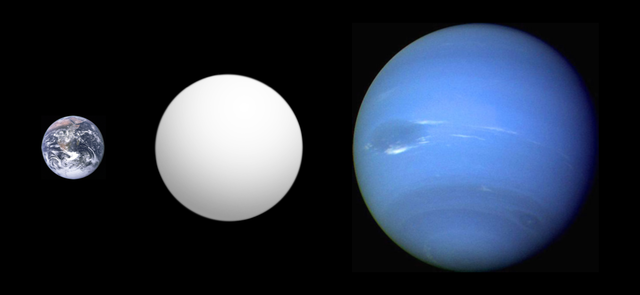Mega-Earth
Terrestrial planet with ten times the mass of Earth From Wikipedia, the free encyclopedia
A mega-Earth is a proposed neologism for a massive terrestrial exoplanet that is at least ten times the mass of Earth. Mega-Earths would be substantially more massive than super-Earths (terrestrial and ocean planets with masses around 5–10 Earths). The term "mega-Earth" was coined in 2014, when Kepler-10c was revealed to be a Neptune-mass planet with a density considerably greater than that of Earth,[1] though it has since been determined to be a typical volatile-rich planet weighing just under half that mass.[2]

Examples
Summarize
Perspective
Kepler-10c was the first exoplanet to be classified as a mega-Earth. At the time of its discovery, it was believed to have a mass around 17 times that of Earth (ME) and a radius around 2.3 times Earth's (R🜨), giving it a high density that implied a mainly rocky composition. However, several follow-up radial velocity studies produced different results for Kepler-10c's mass, all much below the original 17 ME estimate. In 2017, a more careful analysis using data from multiple different telescopes and spectrographs found that Kepler-10c is more likely around 7.4 ME, making it a typical volatile-rich mini-Neptune and not a mega-Earth.[3][2]
K2-56b, also designated BD+20594b, is a much more likely mega-Earth,[4] with about 16 ME and 2.2 R🜨. At the time of its discovery in 2016, it had the highest chance of being rocky for a planet its size, with a posterior probability that it is dense enough to be terrestrial at about 0.43. For comparison, at the time the corresponding probability for Kepler-10c was calculated as 0.1, and as 0.002 for Kepler-131b.[5]
Kepler-145b is one of the most massive planets classified as mega-Earths, with a mass of 37.1 ME and a radius of 2.65 R🜨, so large that it could belong to a sub-category of mega-Earths known as supermassive terrestrial planets (SMTP). It likely has an Earth-like composition of rock and iron without any volatiles. A similar mega-Earth, K2-66b, has a mass of about 21.3 ME and a radius of about 2.49 R🜨, and orbits a subgiant star. Its composition appears to be mainly rock with a small iron core and a relatively thin steam atmosphere.[6]
Kepler-277b and Kepler-277c are a pair of planets orbiting the same star, both thought to be mega-Earths with masses of about 87.4 ME and 64.2 ME, and radii of about 2.92 R🜨 and 3.36 R🜨, respectively.[7]
PSR J1719−1438 b is the most massive mega-Earth ever known with a mass of about 330 ME and a radius less than 4 R🜨. PSR J1719−1438 b is a pulsar planet which is most likely composed largely of crystalline carbon but with a density far greater than diamond.[8][9]
See also
References
Further reading
Wikiwand - on
Seamless Wikipedia browsing. On steroids.
